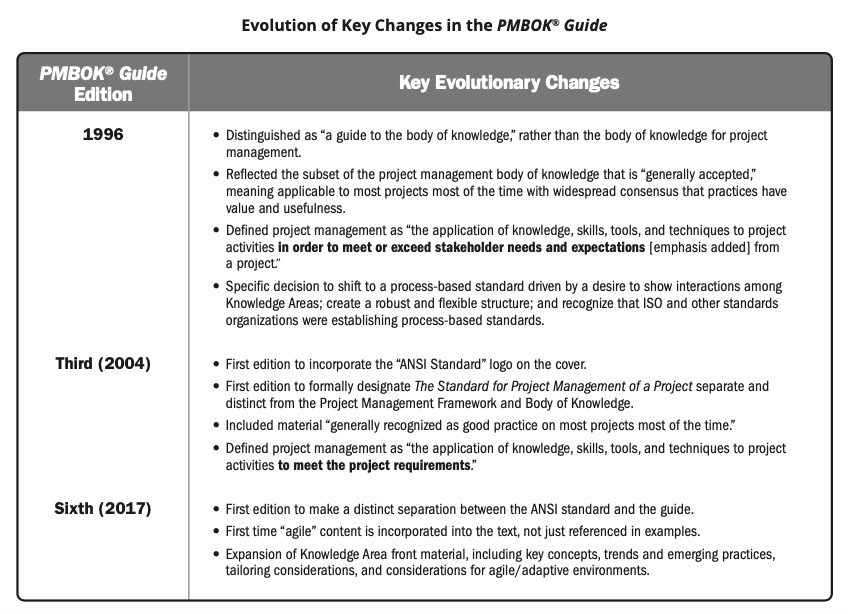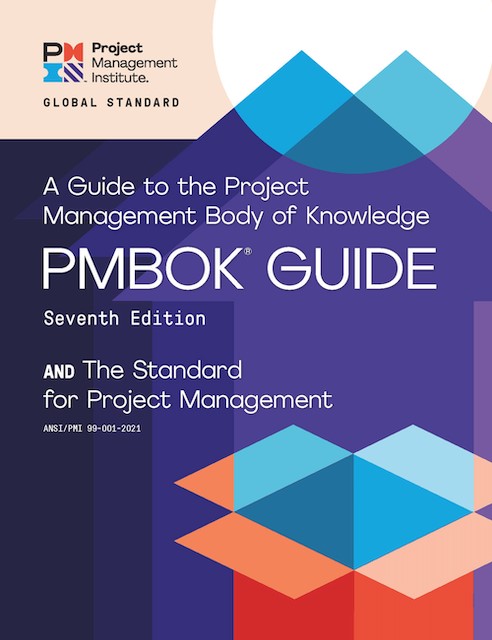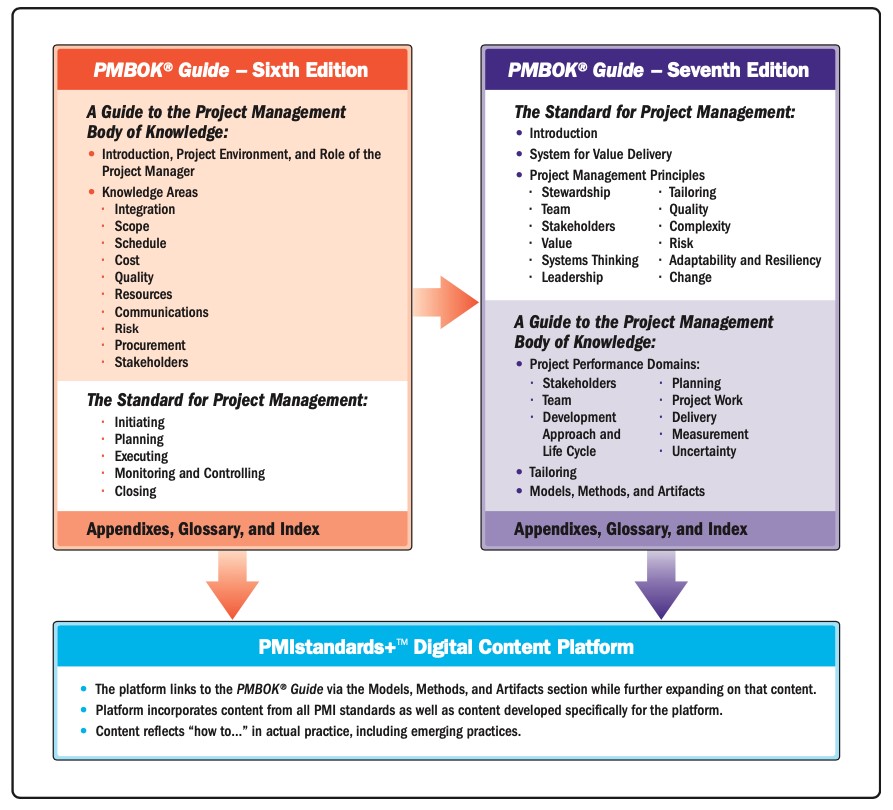Table of Contents
ToggleThe Project Management Body of Knowledge (PMBOK) Guide, a cornerstone resource for project management professionals worldwide, has undergone several revisions since its inception. These updates reflect the evolving nature of project management as a discipline, incorporating the latest trends, technologies, and methodologies. This article delves into the transition from the PMBOK Guide’s sixth to its seventh edition, highlighting the pivotal changes and the rationale behind them. Furthermore, it offers a comprehensive overview of the PMBOK Guide’s evolution over the years, shedding light on its continual refinement in aligning with the dynamic field of project management.

The Genesis and Evolution of the PMBOK Guide
The PMBOK Guide, published by the Project Management Institute (PMI), is designed to provide a framework for managing projects across various industries. Since its first publication, the guide has been periodically updated to incorporate new knowledge and practices. The first edition, released in 1996, laid the foundation for project management standards. Subsequent editions have expanded on this foundation, introducing new processes, knowledge areas, and performance domains, reflecting the growing complexity of project management.
Each iteration of the PMBOK Guide has aimed to address the challenges faced by project managers in an ever-changing project environment. From the integration of technology and Agile methodologies to the emphasis on leadership and strategic business management competencies, the guide has progressively expanded its scope to cover the multifaceted nature of project management.

Source: PMBOK Guide – Seventh Edition
Transitioning from the Sixth to the Seventh EditionThe transition from the Sixth to the Seventh Edition of the PMBOK Guide marks a significant shift in the approach to project management, moving from a process-based to a principle-based framework. This evolution reflects the recognition of the diverse and dynamic nature of projects and the need for a more adaptable framework that can be tailored to varying project requirements.

Key Changes in the Seventh Edition
1. Principle-based Approach: The most notable change in the seventh edition is the shift from a process-centric to a principle-based framework. While the sixth edition focused on processes and knowledge areas, the seventh edition emphasizes 12 principles that underpin project management. These principles are designed to be universal, providing a foundation that can be applied across different methodologies, industries, and project types.
2. Performance Domains: The seventh edition introduces eight performance domains that represent areas of focus or activities essential to effective project management. These domains replace the process groups and knowledge areas of the sixth edition, offering a more holistic view of project management that encompasses a wider range of activities and considerations.
3. Tailoring: Recognizing the need for flexibility in project management, the seventh edition places a stronger emphasis on tailoring. It acknowledges that no one-size-fits-all approach exists and that project managers must adapt principles and practices to fit the unique context of each project.
4. Models, Methods, and Artifacts: The seventh edition provides a compendium of models, methods, and artifacts that support the application of the principles and performance domains. This resource encourages project managers to employ a diverse set of tools and techniques, enhancing their ability to adapt to project needs.
5. Value Delivery System: The concept of a value delivery system is introduced, emphasizing the importance of delivering value to stakeholders throughout the project lifecycle. This perspective shifts the focus from merely completing projects to achieving outcomes that provide tangible benefits.

Source: PMBOK Guide – Seventh Edition
Reasons Behind the Changes
The revisions in the seventh edition were driven by several factors:
1. Adaptability: The dynamic nature of projects today requires a flexible approach that can be customized to suit different project environments. The principle-based framework and emphasis on tailoring address this need.
2. Holistic View: Project management is increasingly recognized as an integrative function that requires consideration of various factors, from stakeholder engagement to value delivery. The performance domains provide a framework that captures this complexity.
3. Agile and Hybrid Methods: The rise of Agile and hybrid project management methodologies necessitated a guide that is applicable across various approaches. The seventh edition’s flexible principles and diverse toolkit support this integration.
4. Focus on Value: There is a growing emphasis on the importance of delivering value, not just completing projects. The value delivery system concept aligns project activities with the overarching goal of creating value for stakeholders.
| Feature | PMBOK – 6th Edition | PMBOK – 7th Edition |
| Framework | Process-based, emphasizing processes within Knowledge Areas. | Principle-based, focusing on universal principles applicable across projects. |
| Organizational Structure | Organized around 10 Knowledge Areas and 5 Process Groups. | Organized around 12 Principles and 8 Performance Domains. |
| Emphasis | Focuses on processes and their inputs, tools, techniques, and outputs. | Emphasizes flexibility and adaptability through principles and performance domains. |
| Guidance | Provides detailed guidelines on project management processes. | Offers high-level guidance based on principles, encouraging tailoring to project needs. |
| Tools and Techniques | Detailed description of tools and techniques within each process. | Introduces a compendium of models, methods, and artifacts to support the principles and domains. |
| Project Environment | Acknowledges varying project environments but less emphasis on adaptability. | Strong emphasis on tailoring practices to suit different project environments. |
| Value Delivery | Implied through the execution of processes. | Explicit focus on delivering value through a value delivery system. |
| Agile and Hybrid Methods | An integrated approach, supporting Agile, hybrid, and traditional methodologies equally. | The integrated approach supports Agile, hybrid, and traditional methodologies equally. |
| Outcome Focus | Focuses on project completion and meeting objectives. | Shifts focus towards outcomes and delivering value to stakeholders. |
Conclusion
The PMBOK Guide’s evolution from the sixth to the seventh edition represents a significant shift towards a more flexible, principle-based approach to project management. This transition acknowledges the diverse, complex nature of projects and the need for project managers to adapt their strategies to meet unique project demands. By emphasizing principles, performance domains, and the delivery of value, the seventh edition of the PMBOK Guide equips project managers with a framework that is both comprehensive and adaptable, ready to face the challenges of modern project management.
To better understand this transition of project management best practices prescribed in the PMBOK Guide require expert help. Spoclearn’s PMP certification training is based on the latest PMBOK Guide – Seventh Edition and our instructor-led program helps learners from any background clearly understand the changes and how to implement them into their projects.
